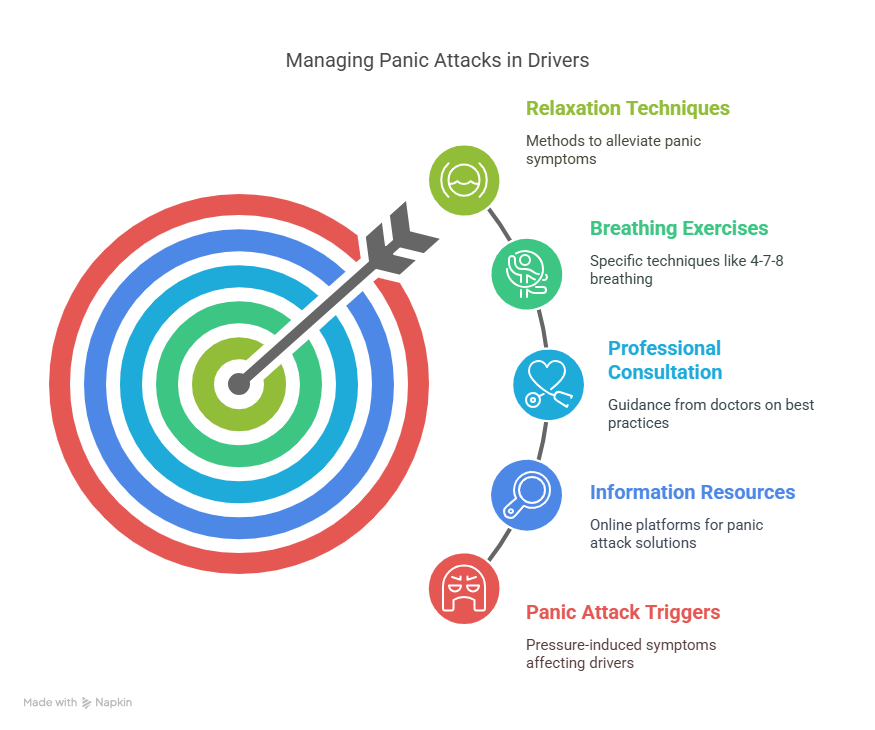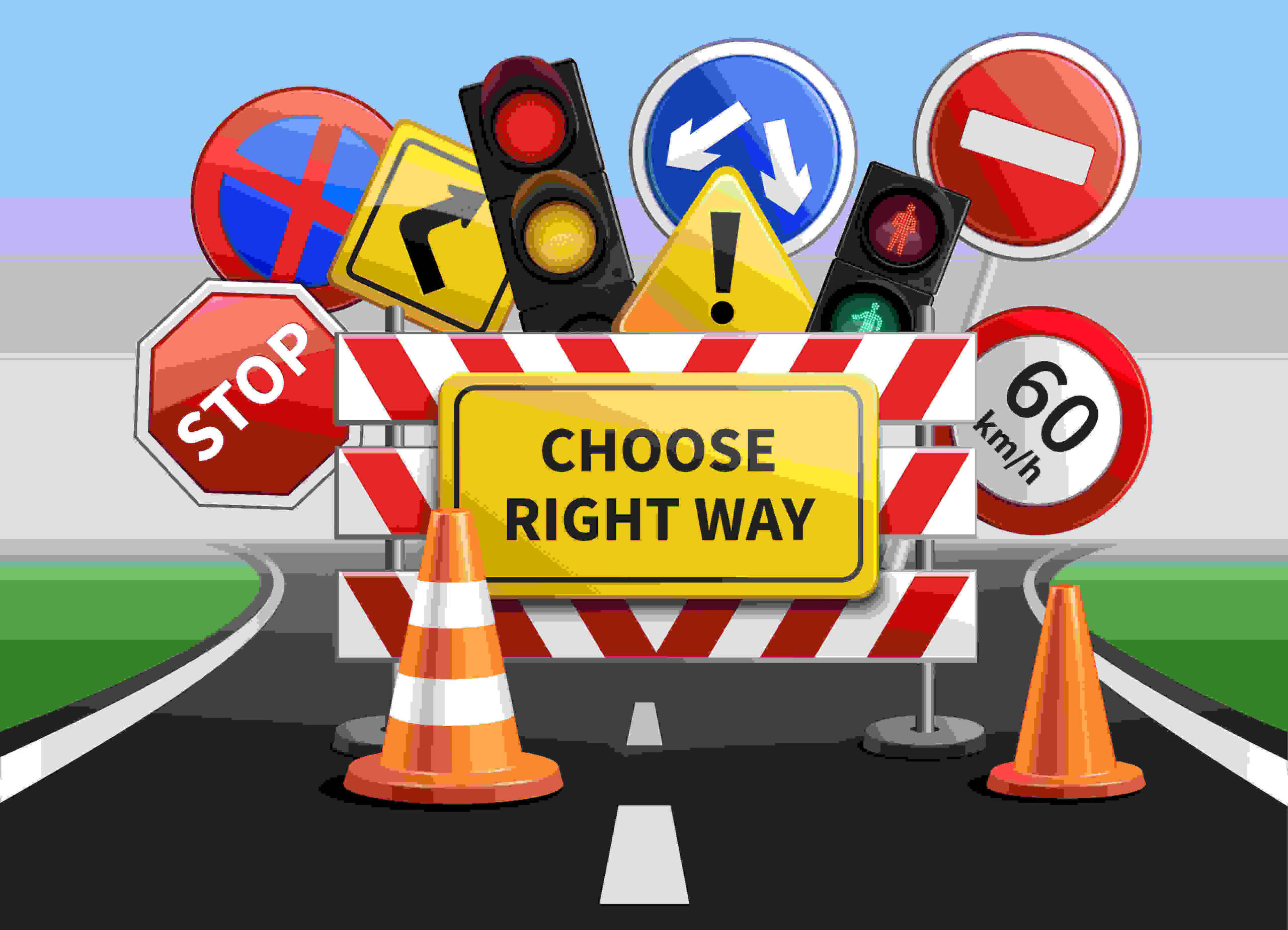Stop Panicking, Start Driving: The Ultimate Guide to Passing Your Test on the First Try!
Imagine sitting in the driver’s seat, palms sweaty, heart racing; your anxiety is through the roof. The examiner gives you instructions, but your mind is blank. Sound familiar? You’re not alone! Up to 35% of people experience a panic attack at some point in their lives before start driving(betterhealth.vic.gov.au).
You need to take time to calm your anxiety before the start driving test. Usually, small worries like forgetting traffic signs or making a mistake cause little panic. A few deep breaths can help if you are feeling nervous.
But big fears like chest pains or shortness of breath are harder. That is why they need therapy or progressive muscle relaxation. You can try different responses to see what works best for your health.
Too much panic can make your heart race like a heart attack. Focus on lights and traffic instead of scary thoughts. 11% of Americans experience a panic attack yearly (my.clevelandclinic.org).
Driving at night or in heavy traffic can make physical symptoms worse. But if you practice in daily life, you gain confidence.
Always check mirrors and stay calm. Good drivers don’t let fear control them.
Stop letting anxiety ruin your focus. Use behavioral therapy tricks if needed. Pass the test first and try to take back your life on the road!
Only 50% of candidates pass the theory test on the first attempt (drivingtheoryworkshop.com).
Driving tests don’t have to be nightmares. With the right mindset, skills, and techniques, you can conquer fear and pass with flying colors!
Understanding the Importance of a Stress-Free Approach
“Only bad drivers fail!”
Wrong; even skilled drivers choke under pressure.
Panic attacks trigger shortness of breath, chest pains, and confusion, making even simple tasks like parallel parking feel impossible.
Search engines like Google are good for finding help with panic attacks. Type “how to stop panic” and you get many ideas. You can make a list of relaxation techniques from websites and check them on YouTube or health apps. Videos show deep breathing exercises that help.
You need to pick methods that work for your panic symptoms. Some people get nocturnal panic attacks at night, others have daytime panic attacks. Ask the doctor which breathing exercises are best for you. Try 4-7-8 breathing or the Breathing Space method to see what helps.

When you feel unexpected panic attacks during start driving, remember:
- Stop Driving
- Do deep breathing
- Wait for the body to calm
Simple techniques like deep breathing help calm your nervous system, while progressive muscle relaxation eases the physical tension that stress brings. The result? A clear, focused mind with sharper reflexes; exactly what you need behind the wheel. Master your emotions, and you master the road.
Choosing the Right Driving School
Learning driving skills needs a good teacher. Not all driving schools are the same!
Many pick cheap driving schools but get bad defensive driving techniques. Then, I failed driving tests many times.
2-3% of Americans suffer from panic disorder (my.clevelandclinic.org).
Don’t let driving be one of your reasons to get a panic attack.
How to Choose the Right Driving School
Picking the right driving school for start driving so that can shape your entire learning experience. Check the teacher’s experience; for example, Barry Smith Driving School has over 20 years of proven results.
Make sure the cars are in excellent condition, as newer vehicles provide a safer and smoother learning environment. And most importantly, choose a school that teaches defensive driving skills; it’s not just about passing the test, it’s about staying safe for life on the road.
| Before | After |
| Nervous, inconsistent driving | Confident, smooth maneuvers |
| Poor defensive driving skills | Expert-level road awareness |
Proper preparation goes beyond memorizing rules; it helps you master real-world driving skills, not just theory. You’ll learn how to react calmly and correctly in dangerous situations, building the confidence you need. And when test day comes, you’ll feel more relaxed and in control because you’ve already practiced like it’s the real thing.
Your driving tests are not about luck – about good learning! Cheap schools may cost more time!
Familiarize Yourself with the Test Area (Beat the Unknown!)
Knowing the test road makes driving exams feel easy. No scary surprises! Many fail driving exams because they have never seen test road conditions before. Then I panic when I see new Road signs.
For Example
You’re taking your test in a new area. Suddenly, a hidden stop sign appears; panic sets in! Knowing the road rules and traffic signs in advance prevents last-minute mistakes.
Why Road Exam Prep Work:
- Feel like you start drive here before
- Know all traffic signs locations
- No nervous when tester watch
Want to boost your chances of passing on the first try? Practice with mock test simulations on actual test routes; you’ll feel right at home on exam day. Add in night start driving sessions to build confidence in low-light conditions.
P.S. Knowing the test road well can raise your pass rate by up to 90%!
Learn Test Road Rules Smart Way:
| What Do | Why Help |
| Start Drive test road at night | See how the signs look dark |
| Count all stop signs | Remember where stop |
| Watch other drivers | Learn tricky spots |
Knowledge = power. Study the test area like a pro!
Mastering Essential Observations (Eyes on the Prize!)
Sharp eyes make you a defensive driver. See danger before it happens! Most drivers fail because they miss Road signs or do not see the mistakes others make. Then panic when tests come.
Common Mistakes vs. Solutions
| Mistake | Solution |
| Missing blind spots | SMOG technique (Signal, Mirror, Over-shoulder, Go) |
| Ignoring road conditions | Defensive driving techniques |
| Speeding | Observe speed limits; use cruise control on highways |
| Distracted driving | Put the phone away; use hands-free devices only for essential calls |
What Experienced Drivers Do Without Thinking
Seasoned drivers develop a kind of sixth sense behind the wheel. They can spot icy patches before a slide happens, anticipate traffic light changes, and react instantly when a child runs after a ball.
These quick, almost automatic responses come from practice, awareness, and the right training, skills every new driver can learn with time.
Pro Tips:
| What Watch | Why Help |
| Other car wheels | Know when they turn |
| Road signs far ahead | Have time react |
| People near road | See if they walk to street |
Sharp observations mean fewer mistakes and greater control on the road. Great start driving isn’t just about steering and pedals; it’s about using your “eagle eyes” to notice everything happening around you.
P.S. A responsible driver never says, “I didn’t see that.” Train your focus, and you’ll drive safer, smarter, and more confidently.
Managing Test Anxiety (From Panic to Power!)
Dealing with anxiety is a big world. Some people get panic attacks during tests, others feel intense anxiety all the time. You need to look at what kind of help works best for your feelings of anxiety.
First, check different anxiety toolkit ideas. The 3-3-3 rule helps when you feel panic coming – name 3 things you see, 3 hear, and move 3 body parts. This trick is good for daytime panic attacks or unexpected panic attacks.
3-3-3 Rule for Panic Attacks:
- Name 3 things you see.
- Name 3 sounds you hear.
- Move 3 body parts.
For nocturnal panic attacks that wake you at night, try keeping a notebook by your bed. Write down the panic symptoms you feel. Next day, show the doctor to understand your panic disorders better.
See what other people with panic disorder say works best. Some like an anxiety toolkit with breathing exercises, and others need talk therapy for anxiety disorders.
Remember:
- Panic attack symptoms feel scary but are not dangerous
- Concentrated anxiety before test normal
- Your anxiety symptoms do not mean you weak
Using the right techniques can instantly reduce intense anxiety and help you stay in control, even under pressure. Practicing calm before bed can also prevent those restless, panic-filled nights leading up to your test. Conclusion: Don’t let anxiety take the wheel; you’re the one start driving.
Test-Day Preparedness (Your Blueprint for Success!)
Rush parking makes you fail a test. Need to take ample time to do things right! People often hurry and forget the parking brake or hit the curb during Parallel parking. Then test over fast.
You need to stay calm so that you don’t get a panic attack out of anxiety. 13% of people experience a panic attack in their lifetime (cchwyo.org).
Checklist:
- Get ample time for rest.
- Avoid caffeine (it triggers rapid breathing).
- Pack essentials (license, glasses, parking brake knowledge).
Use Your Time the Smart Way During the Test
Taking a few extra seconds can make all the difference. Double-checking your parking space helps ensure you don’t bump into other vehicles, while using the parking brake every time shows the examiner you’re focused on safety. And don’t forget to take a deep breath before starting; it calms your nerves and sets you up for a smooth, confident drive.
Why Staying Calm is Necessary:
- Less stress means thinking clearly
- More time means fewer mistakes
- Good parking spot choice easy when not rush
Remember, your start driving test isn’t a race; slow and steady truly wins every time. Take your time, stay calm, and focus on each step. The majority of those who fail say, “I went too fast!” Try waiting three seconds before moving off; it might just be the pause that earns you a pass.
Drive with Confidence & PASS!
Getting good at driving needs special skills. If you get too much anxiety, better to get help than to try alone. Instead of wasting time being scared, let driving teachers show you how. They know all about traffic signs and will help you pass the test easily.
When Panic Comes While Driving, Remember:
- Take deep breaths to calm your heart
- Pull over if you feel chest pains or shortness of breath
- Use progressive muscle relaxation at red lights
Physical symptoms like a fast heartbeat feel like a heart attack but are not real. That’s just your anxiety talking. At night, use lights well so you see clearly and feel safe.
Many drivers make small mistakes but still pass. In your daily life, practice behavioral therapy tricks to stay calm in traffic.
Good drivers aren’t just skilled; they’re prepared. They constantly check their mirrors, staying aware of everything around them. They know their traffic signs by heart, making smart, legal decisions. And they even have a plan for staying calm during moments, because safety starts with a clear mind.
No more fear – just focus on the road and pass that test!
You’ve got this! Panic attacks and start
driving tests don’t stand a chance against your preparation.
FAQs (Burning Questions Answered!)
1. How do I stop panicking during my driving test?
Use deep breathing exercises (like 4-7-8 breathing) to instantly calm your nerves!
2. What if I make a mistake during the test?
Mistakes happen! Even experienced drivers slip up. The key is staying composed, correct safety following road rules, and keep going.
3. How can I prepare for unexpected panic attacks before the test?
Practice progressive muscle relaxation daily and simulate test conditions with mock start driving exams.
4. Is it normal to feel like I’m having a heart attack during a panic attack?
Absolutely! Panic attack symptoms (like chest pains, shortness of breath, rapid heartbeat) mimic a heart attack, but they’re not life-threatening.



